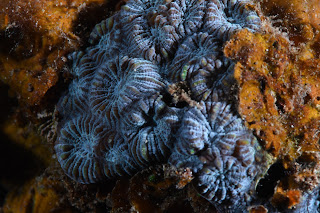Satisfied: part 2
Last fall, I had an idea. I was spending so much time and energy trying to imitate the substrata that corals settle on, maybe I should just give up and sample them where they're at. Corals settle on dead corals. If you look hard enough on any reef, you're bound to find some tiny baby corals living on the limestone. So I should just sample them there, right?
 |
| One of the coral recruits at Mecherchar |
Oh, what is my secret weapon, you ask? That would be a man by the name of Matthew-James Bennett. He joined our team this trip to help with coral spawning, but his skills do not stop there. Matt can spot a baby coral on a reef like nobody else I have ever known. The man must have microscopes for eyes, because he just picks them out all day long. If humanity ever manages to monitor coral recruitment from space, I guarantee Matthew will be involved somehow. Probably as the official coral baby finder. His skills are ridiculous.
So here's how it went down: I was underwater with my macro lens, photographing the smallest corals I could find, which were all a few polyps across, and then I heard a high-pitched "tink, tink, tink." I turned to find Matthew, banging scissors against a piece of metal to get my attention and pointing to the tiniest coral I have ever seen. Then I swam over and photographed it while trying not to lose track of where it was! This happened so many times.
I am extremely grateful for Matthew's eagle eyes, because they had a huge impact on the quality of our data. Thanks to his experience and the magic of macro photography, I am finally able to sample high numbers of recruits at each of my study sites! (But I'm still not satisfied.)

Comments
Post a Comment